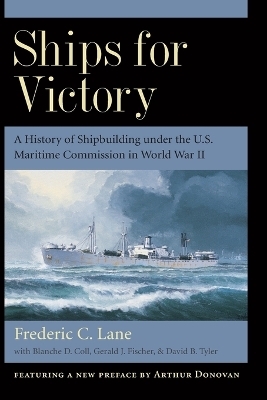
Ships for Victory
Johns Hopkins University Press (Verlag)
978-0-8018-6752-1 (ISBN)
- Lieferbar (Termin unbekannt)
- Versandkostenfrei innerhalb Deutschlands
- Auch auf Rechnung
- Verfügbarkeit in der Filiale vor Ort prüfen
- Artikel merken
During World War II, America's shipbuilding industry, mobilized under the U.S. Maritime Commission, set records of production that have never been equaled. Given the daunting task of building ships faster than they were being sunk, shipbuilding firms across the country found new ways to increase their efficiency and scale of production. Huge new shipyards were built, a labor force of 640,000 was employed, and over 55 million deadweight tons of ocean-going ships were delivered, including the famous Liberty and Victory ships. First published in 1951, Ships for Victory chronicles this remarkable wartime program in magisterial detail: the development of revolutionary construction methods; the upheavals in management, awarding of contracts, and allocation of steel and other materials; the recruitment, training, housing, and union activities of the workers; the crises, confusions, and scandals that arose; and the role of shipbuilding within the total war effort.
Frederic C. Lane (1900-1984) was a noted maritime historian of medieval and Renaissance Venice. Among his many books are Venetian Ships and Shipbuilders of the Renaissance and Venice, A Maritime Republic, both available from Johns Hopkins. Arthur Donovan is a professor of humanities at the U.S. Merchant Marine Academy.
Contents: Preface to the 2001 Edition, by Arthur Donovan Preface to the 1951 Edition Chapter 1: The Commission and the Shipbuilding Industry Chapter 2: Emergency Shipbuilding before the Declaration of War Chapter 3: Design and Initial Procurement for the Liberty Ship Chapter 4: Contracts with Shipbuilders and Their Supervision Chapter 5: Expansion and Reorganization after Pearl Harbor Chapter 6: Excess Capacity and the Cancellation of the Higgins Contract Chapter 7: Speed and Productivity in Multiple Production Chapter 8: Building the Labor Forc eChapter 9: Collective Bargaining Chapter 10: The Battle for Steel Chapter 11: Guiding the Flow of Materials Chapter 12: Increasing the Supplies of Components Chapter 13:Stabilization and Morale in the Labor Force Chapter 14: Managing Managements Chapter 15: Changing Managements Chapter 16: Cracks in Welded Ships Chapter 17: The Victory Ship Chapter 18: Military and Minor Type sChapter 19: The Contrast between 1943 and 1944 Chapter 20: The Manpower and Managerial Crisis Chapter 21: Administrative Problems-(A) The Regional Offices Chapter 22: Administrative Problems-(B) The Flow of Mone yChapter 23: Administrative Problems-(C) The Commission and the War Shipping Administration Chapter 24: Adventures in Hindsight Biographical Note Index
| Erscheint lt. Verlag | 16.11.2001 |
|---|---|
| Co-Autor | Blanche D. Coll, Gerald J. Fischer, David B. Tyler |
| Vorwort | Arthur Donovan |
| Zusatzinfo | 50 Charts; 28 Halftones, black and white |
| Verlagsort | Baltimore, MD |
| Sprache | englisch |
| Maße | 152 x 229 mm |
| Gewicht | 1270 g |
| Themenwelt | Geschichte ► Allgemeine Geschichte ► 1918 bis 1945 |
| Geisteswissenschaften ► Geschichte ► Regional- / Ländergeschichte | |
| Geschichte ► Teilgebiete der Geschichte ► Militärgeschichte | |
| Geschichte ► Teilgebiete der Geschichte ► Technikgeschichte | |
| Technik ► Fahrzeugbau / Schiffbau | |
| ISBN-10 | 0-8018-6752-5 / 0801867525 |
| ISBN-13 | 978-0-8018-6752-1 / 9780801867521 |
| Zustand | Neuware |
| Informationen gemäß Produktsicherheitsverordnung (GPSR) | |
| Haben Sie eine Frage zum Produkt? |
aus dem Bereich


